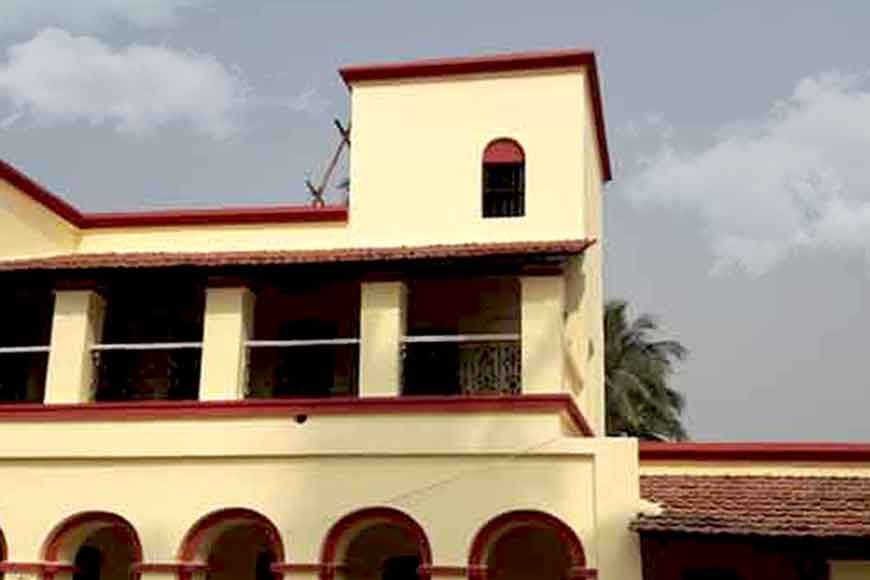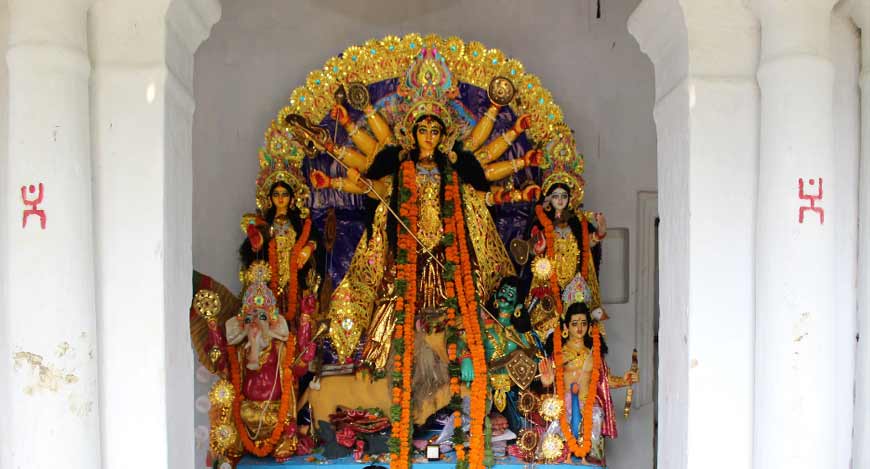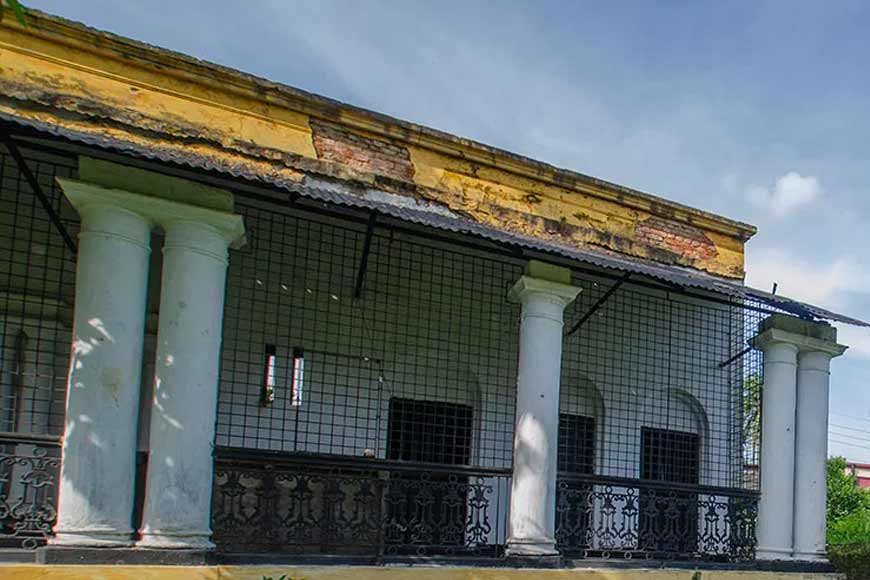Celebrating Durga Puja at Netaji's house in Kodalia

“Why do we seek Mother? The reason is any worship is incomplete without the presence of Mother. In our society, whenever we have sailed too close to the wind, we have invoked Mother to protect us. With all our intellect and imagination put together, we have created the concept of the Mother…. All human beings seek a steady anchor in life and that is attainable only by unconditional faith and devotion in the concept of the Mother – one who evokes conviction and piety. In Durga, we see Mother, Motherland and the Universe all in one. The underlying principle behind worshipping the idol of Goddess Durga is to convene the infinite within a finite shape. I seek divine blessing so that I can continue to worship Mother with this spirit all my life.”
This is a rough translation of a selected part of a letter written by Netaji Subhash Chandra Bose to Basanti Devi, wife of his political guru, Chittaranjan Das. Bose considered her his foster mother and was very close to her. He often discussed myriad social and political issues with her and sought her advice and views. He looked up to her for solace during trying times. He had expressed his views about Goddess Durga, whom he envisaged at once as Mother, Motherland and the Universal spirit.
Subhas Bose’s biographer, Leonard Gordon had observed, "Subhas issued no public statements on religion, but his Hinduism was an essential part of his Indianness’’(‘Brothers Against the Raj – Biography of Indian Nationalists, Sarat and Subhas Chandra Bose’). Gordon wrote, "His mother was devoted to Durga and Kali’’ and… his inherited and chosen form to worship the divine was in the form of the Mother Goddess, especially as Durga or Kali.’’ An even cursory perusal of Bose’s letters, in particular to his close family members and apolitical friends, as also accounts of his contemporaries who were close to him, establishes the same.

In ‘Bharat Pathik’, a vernacular journal of the time, Bose wrote how he actually envisioned Durga Puja. During the 1920 and 1930s, the emergence of community puja transformed Durga puja from a rich men's puja to a people's festival, and Bose decided to make good use of the change and induct youngsters as freedom fighters and intensify the militancy of the Swadeshi movement. ‘Beerashtami’ was introduced that marked the worship of valour as part of the worship of ‘Shakti’. He even invited his readers to visit the annual autumnal festival held at his ancestral house in Koldalia village in South 24 Parganas. Located approximately 25 kilometers from Kolkata, in the southern fringe of the city, Kodalia has been rechristened Subhasgram in honour of the illustrious son of the soil.
In the 1920s, there were a few revolutionary groups active in Kodalia. Netaji wrote in his diary that he would visit Kodalia during the Puja to meet revolutionaries here. Kodalia is the home of the renowned revolutionary leader M.N. Roy born as Narendra Nath Bhattacharya. Sivanath Sastri also hailed from the same village.
From Subhasgram railway station, one has to travel two kilometers by rickshaw and auto to reach Kodalia, subhas Chandra's ancestral home, Haranath Lodge. Netaji’s grandfather, Haranath Bose, built the family home in 1760 on 10 cottahs of land, and it was named ‘Haranath Lodge.’ He introduced Durga Puja in 1820 and since then, the house has been hosting Durga Puja for the past 200 years. The Sonarpur-Kodalia Durga Puja of the Bose family is very famous and people from different parts of the world throng here to watch this heritage puja.
The Bose family originally hailed from Mahinagar, a neighbouring village, named after one of the ancestors of the family, Mahipati Bose. Mahipati was given the title of ‘Subuddhi Khan’ by the Sultan of Bengal who also gifted him a jagir (land grant). In 1707, the Bose family left Mahinagar and settled in Koldalia. The family’s Durga Puja was first arranged by Jadab Chandra Bose, the then-patriarch of the Bose family at the behest of his widowed sister and the tradition continued after him by successive generations of patriarchs of the Bose family. Netaji’s father Janakinath, too, took up the responsibility and organzed the puja. It is learnt from records that Netaji had participated in the ancestral Puja only thrice – 1928, 1937 and 1938. Much later, Gobinda Chowdhury, who was married to a daughter from the Bose family, had also taken charge of organizing the puja for several years.
The wooden macha of the former one-sided mother's statue is two hundred years old. According to the tradition, idols are made every year in that structure. Initially, the pantha was sacrificed, but it has stopped for many years. Ever since Janakinath's father Harnath converted to Vaishnavism, cucumbers, sugarcane and moulds have been sacrificed in place of animal sacrifices.
The traditional ‘ekchala idol’ of Goddess Durga, and her four children—Kartikeya, Ganesha, Saraswati, and Lakshmi are all sculpted in one wooden frame that was used ever since Durga Puja was initiated in the Bose family. the frame itself is two centuries’ old. Following custom, the idols are sculpted on the same wooden frame. In the initial years after the Puja was introduced, animal sacrifice was an integral part of the four-day ritual but the tradition was stalled by Janakinath’s father, Haranath, who became a devout Vaishnava and took the path of non-violence. So, animals were replaced by vegetables and thus, ash gourd, sugarcane and cucumber were ‘slaughtered’ in front of the Devi instead of animals.

Most of the parceners of the Bose family live either in Kolkata or abroad. However, they all try to adjust their schedules to spend the Durga Puja at their ancestral home. It is truly a homecoming time for the Bose clan. Sandhi Puja is an integral and important part of Durga Puja, Sandhi Puja is performed at the juncture of the 8th and 9th lunar day. All family members along with their friends and relatives participate in the rituals during this auspicious moment. Netaji spent a considerable time of his life on this ‘Thakur-dalan’ during the Pujas.
Spread over a large area Haranath Lodge comprises of a number of separate blocks. The Durga Dalan with its impressive entrance is located in the south-west corner of the residential blocks. It is a single storey structure with broad columns. To the south of the house is a pond. The house is a simple two-storey building, with arches and wooden rafters holding up the roof. There are eight rooms in all. Cast iron railings adorn the first-floor balcony. ‘Haranath Binapani Library’ housed within the building is still functional and is a treasure trove for bibliophiles. The library was set up by Janakinath in memory of his father, Haranath, on October 17, 1920.
The house was in a dilapidated condition but the state government announced it as a Heritage House and extensive restoration work was initiated with the help of the Heritage Commission in 2015. Plans are afoot to transform two of the rooms into guest rooms for tourists.
The part of the house where Janakinath lived with his wife before they migrated to Cuttack, have been converted into a private museum where family photographs and knick-knacks used by Netaji and his parents have been meticulously preserved and are on display. Times have changed and Maa Durga has become a wonderful dichotomy that the society approves and ascribes to – she fiercely protects us from evil but she also looks after her family with love and care. Maa Durga successfully becomes a metaphor for the modern women.










